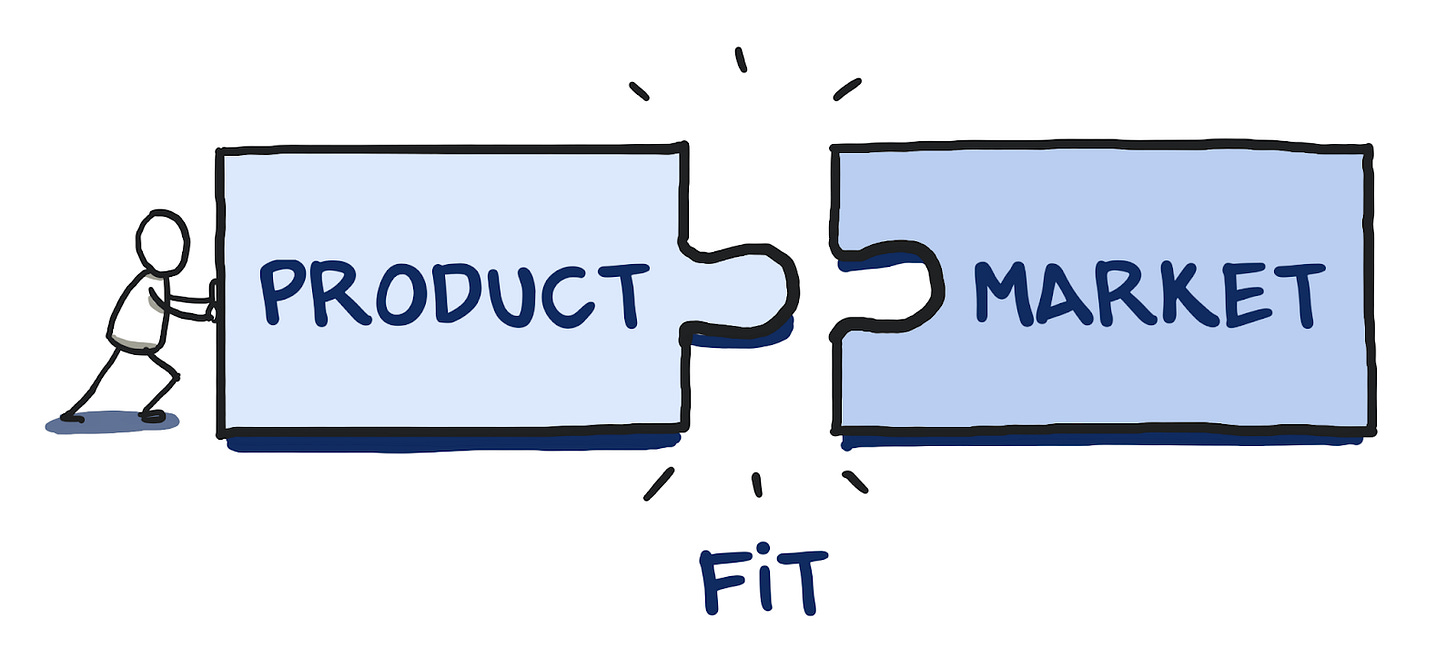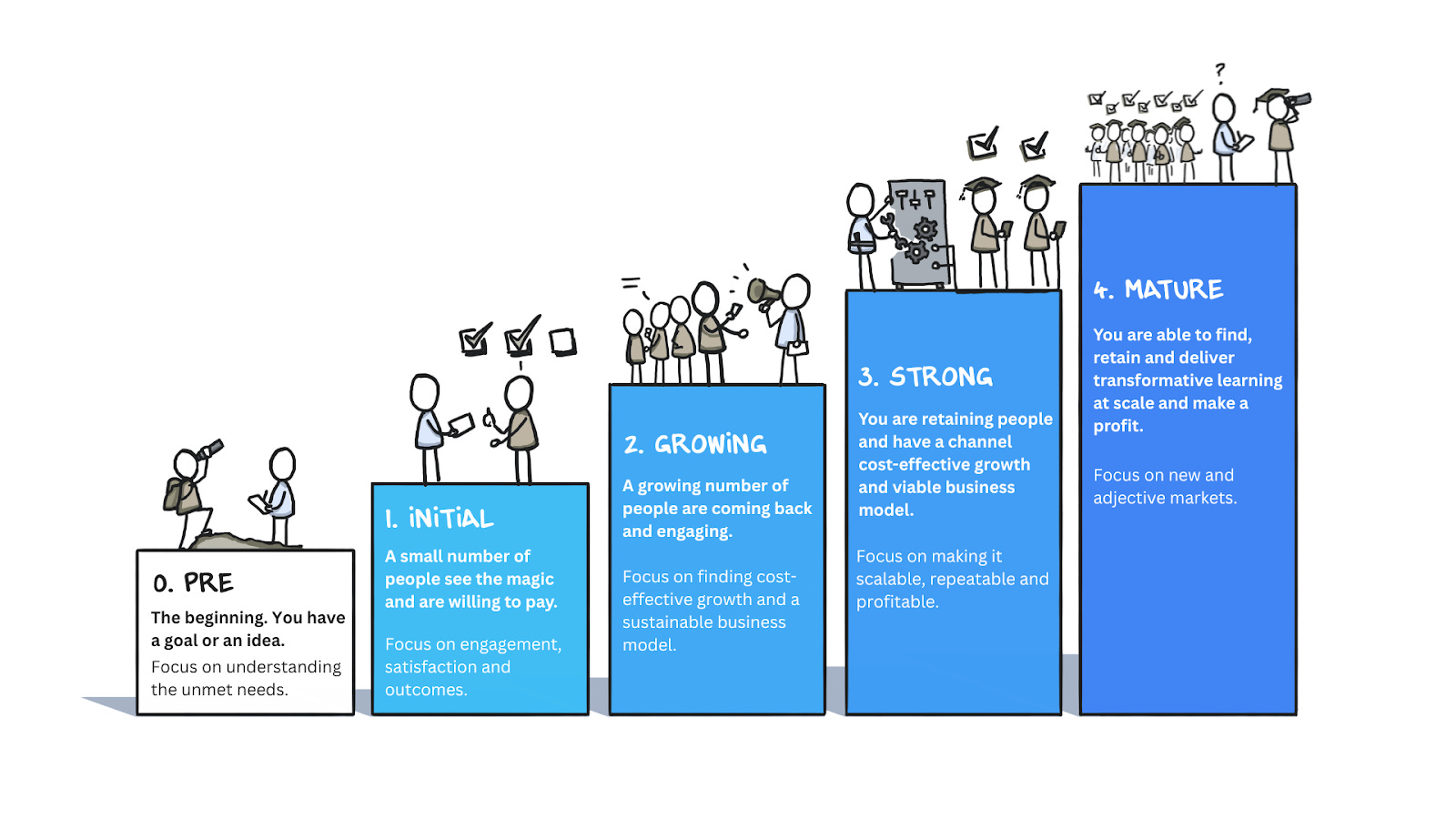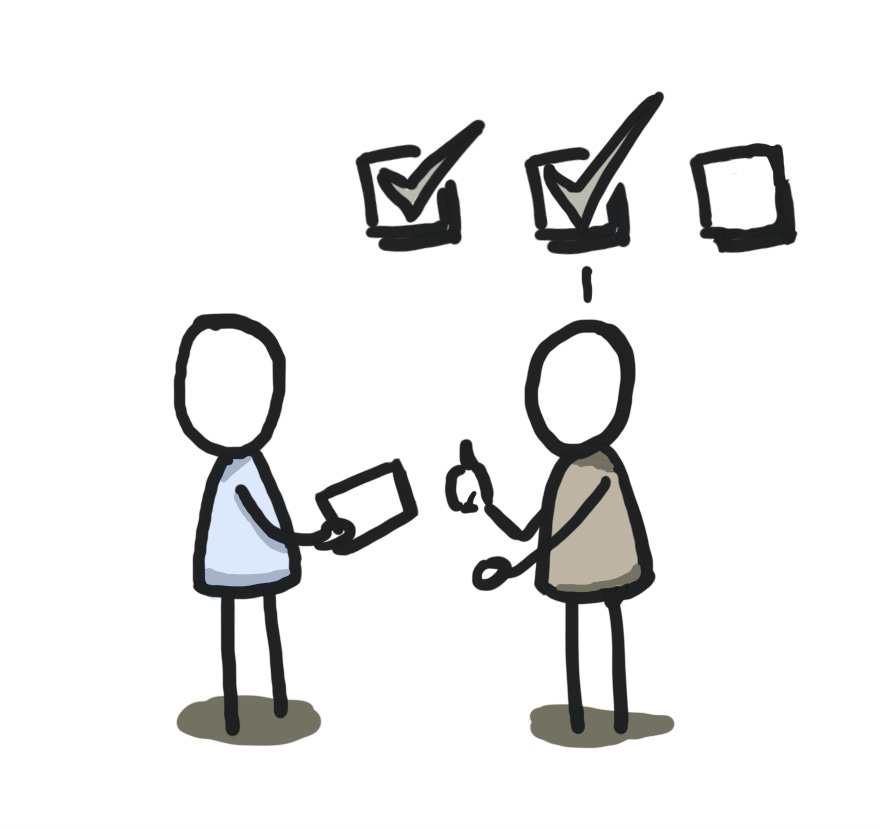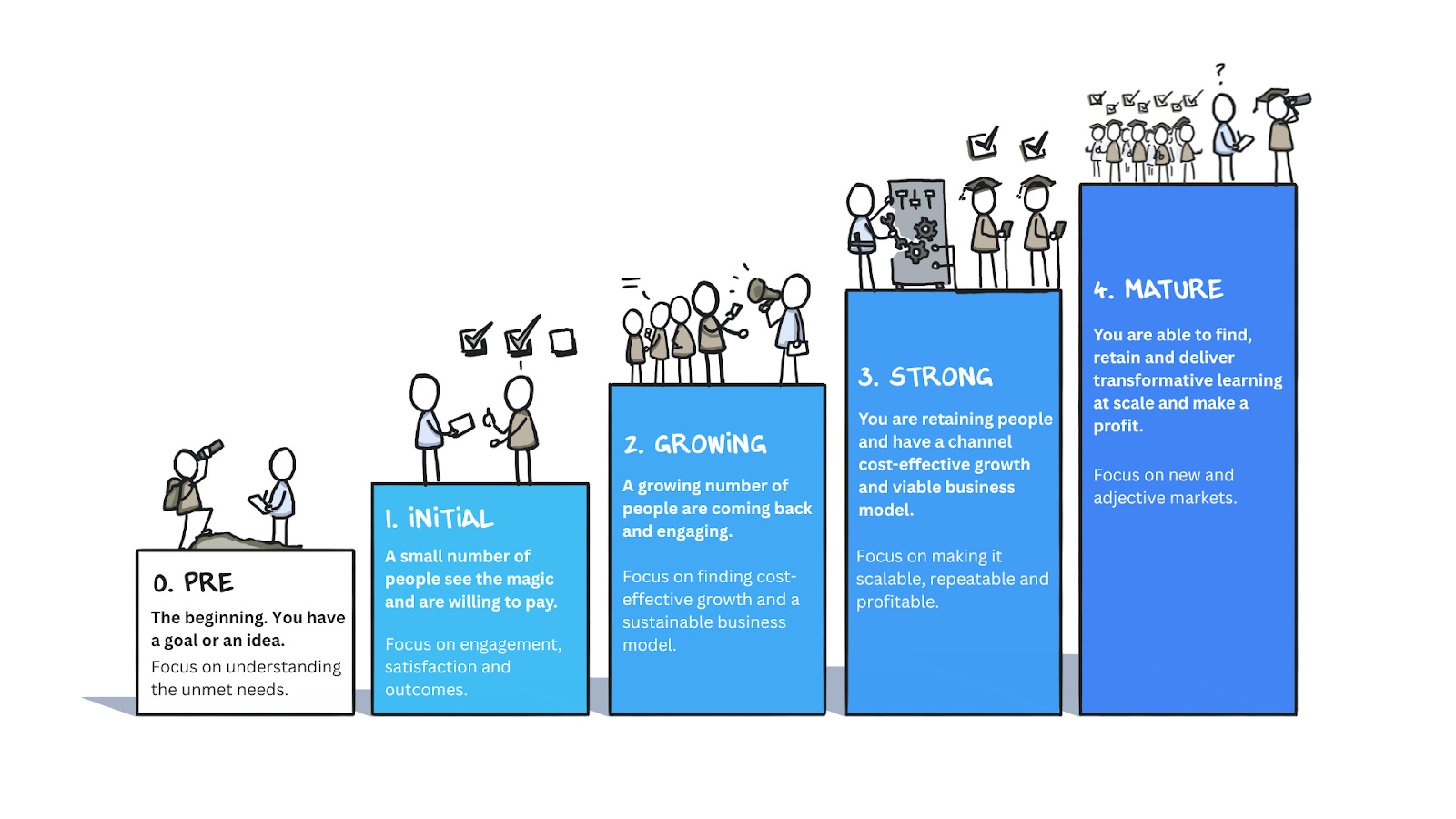Product-Market Fit for Learning 2: Stages
In the second of this 2-part guide, we explore how product-market fit is not a one time moment. It’s a series of stages.
See part 1 here.
One of the biggest myths about product-market fit is that it is a single moment. When you’ve found it, there’s no looking back.
It’s not.
Instead, it is a spectrum, a number of levels that you work through to increase the fit as the product matures through a series of common life stages.
Product-market fit is also something that you can lose as the needs of the people you’re serving and context change or others find better and more efficient ways to deliver the same outcomes. The goal posts are constantly moving because the market continues to move and evolve around you. The job of improving and retaining product-market fit never stops.
This is as true for products and experiences that help people learn as much as other products. Whether they are programmes, technology platforms or other kinds of experience.
In the last article, we looked at the four dimensions of Product-Market Fit for transformative learning products: Aspirational, Effective, Viable, Possible.
Now let’s look at the common stages that products typically go through. This can help simplify the complex challenge of what to focus on when.
The stages
The common milestones typically look like this:
Pre PMF: You’re at the beginning. It’s just a goal or idea.
Initial PMF: A small number of people ‘see the magic’ and are willing to pay.
Growing PMF: A growing number of people are coming back and engaging.
Strong PMF: You are retaining people and have found a channel for cost-effective growth and a viable business model.
Mature PMF: You are able to find, retain and deliver transformative learning at scale and make a profit.
Whilst you need to keep the four dimensions in mind at all times, your focus should change at each of these stages:
Pre PMF: Focus on discovering something Aspirational. Understand the unmet needs.
Initial PMF: Focus on making it Effective. Engagement, satisfaction and outcomes.
Growing PMF: Focus on making it Viable. Find cost-effective growth and a sustainable business model.
Strong PMF: Focus on making it Possible. Scalable, repeatable and profitable.
Mature PMF: Focus on finding new and adjacent markets. Back to Aspirational.
Let’s explore these stages in more detail. What they feel like, the activities that you need to focus on and how to measure success. I’ll also include lots of examples. Follow the links to read the full case studies.
0. Pre PMF: Discover something aspirational
This is the start: you are yet to find people that are willing to use and pay for your product. You or your organisation probably have some specific insights, expertise or capabilities in the space that you’re interested in exploring. You may well have a good understanding of the opportunity and ideas about potential solutions.
The trap that many fall into is focusing on what they can offer and jumping to create that, rather than spending time understanding the needs and pain points of those that they are seeking to serve and finding ways to quickly test their assumptions and potential solutions.
If your product is specifically about learning, educators will often have strong preconceptions about what someone needs to learn and how. Whilst this expertise is crucial to design effective learning products, it shouldn’t replace understanding the context, motivations and outcomes that learners are looking for.
These should be inputs that help these experts design their solution. Being able to design with specific people in mind and know what works for them makes the job easier and you can be more confident about your decisions.
Identify the audience
At this stage, you should focus on specific groups of people you want to help and dig deep into understanding them. Where do they have a need or goal that is important enough to them to spend money on? How much are they willing and able to spend? What are the important characteristics of a solution that might work for them and their context?
You also need to have an idea of how many people have this specific problem - what is the size of the market? Or more importantly, how many of these people could you realistically reach?
Many products struggle further down the line because the problem they are addressing is simply too niche or not important enough to a sufficient number of people to create a viable business.
Examples
Trilogy spotted a growing trend in coding bootcamps and universities doing partnerships with private providers to deliver online degrees. They combined these insights to focus on an audience interested in doing university badged bootcamps.
Zen Educate’s founder saw how painful it was for school leaders to find supply teachers and that it cost them a lot in agency fees. They saw the potential for a technology solution.
Understanding needs
Right now it is about leveraging your existing audience, networks and doing cold outreach to speak to people that look like your target audience.
You want to interview people using techniques like Jobs To Be Done, to uncover in specific contexts, what they are motivated to do and the outcome they want to achieve. It is often more helpful to get them to tell stories about things they have done in the past, than to get them to hypothesise about what they might do in the future. This is where more reliable insights are found.
Your goal is to build a thorough understanding of your specific audience and the outcome you are helping them achieve.
Finally, you need to understand how these people currently address the problem or what else they might consider. You need to find out what solutions already exist and how an alternative might need to be different for them to consider using it instead.
Note that the key point here is to identify something that is different, not better. Better is subjective and you’re likely to be biased.
Examples
Springboard used Jobs To Be Done interviews to understand that people following their MOOC pathways were looking to switch careers and needing support to make the change.
Butter’s cofounders interviewed 400-500 people running online workshops in the first six months. This gave them a really clear idea of the pain points they were addressing: the need for too many tools and tabs to run an engaging session.
Expert insights
You should also speak to experts, to understand their specific insights on the market. There may be good reasons why people aren’t offering the kind of solution you are exploring, or you may uncover particular dynamics that you need to be aware of.
Remember though, that these are different kinds of insights to those you gain by speaking to the people using or participating in your product: don’t confuse them.
Examples
Kahoot! worked closely with teachers in schools to understand how their social quizzes would work best in the classroom.
The London Interdisciplinary School interviewed business leaders and ran co-creating workshops to understand what challenges their alternative MBA should address.
Run Minimum Viable Tests
At this point, you also want to run lots of experiments, or Minimum Viable Tests. How can you test your ideas and get a reaction as quickly as possible, without needing to build a Minimum Viable Product until you have more confidence?
These could be desirability tests, like showing potential customers a landing page or getting them to use a prototype to get a reaction. What do they find interesting? What turns them off or do they find confusing?
It could also be delivering a specific part of the experience like a workshop, a short learning experience or specific feature that represents the riskiest assumptions that you’re making. Do they use it? Is it satisfying? Does it change their behaviour?
What is the ‘atomic unit’ you can test?
It is also useful at this stage to explore how valuable this is to them: how much would they pay for it? In terms of value, what things would they compare it to?
Examples
BridgeU’s founder took an iPad with a prototype of her university guidance solution when she was interviewing school leaders about what support their students needed.
Skiller Whale ran in person coaching sessions, using physical pieces of paper with their early clients in order to understand the dynamics of small team coaching before building their remote ‘micro workshops’ product.
What to measure to find initial PMF
The success metrics are that you have a small group of people that ‘see the magic’. They are signing up and, ideally, willing to pay for the product. This could be organisations that are willing to co-create with you or individuals that are early adopters and love your new, unique take on the problem.
You need to identify this ‘beachhead’ of people that you can work with in order to reach the next stage: making it effective. This could be by going to places that they hang out online or in the real world, inviting your existing networks of users or building a community, getting publicity or working with partners or influencers. Whatever you need to do.
Warning signs are that you’re struggling to book in research interviews, get replies to emails and people aren’t willing to sign up.
Many organisations create a product and then struggle to sell it. It’s normally because they have skipped this stage of finding something that a specific group genuinely finds aspirational. If this is you, go back to this stage.
You’re now ready to go from Minimum Viable Tests to creating your Minimum Viable Product.
Examples
Multiverse only builds a programme once they have sold a target number of seats on their apprenticeships.
Springboard ran a pilot of their new Career Track product with 10 volunteers, achieving an 80% job placement rate, which gave them confidence to invest in the full product.
1. Initial PMF: Make it effective
Once you have found something that people aspire to, you now need to deliver on the promise to your early adopters and make it effective.
You need to create engagement and ensure that people are satisfied enough to keep coming back and to tell others about it.
Typically, this stage is also about identifying which segments are the people to double down on - these are the ones that would be really disappointed if your product went away.
It may also be about uncovering which aspects of your product are the ones that they are engaging with most and focusing on these. Sometimes these insights can lead to a significant pivot from your initial ideas.
Identifying who really needs it
Alongside continuing to do qualitative research, like interviews, you can also gain insights about which are your most engaged people and why this is by running more quantitative research like the Product-Market Fit Survey.
This is asking them about how disappointed they would be if your product went away. If more than 40% are, this is a good indication that you have got initial product-market fit with this group. Where the survey becomes most interesting is by asking questions to find out which segments feel that way and why.
Example
Busuu used the product-market fit survey to confirm that more than 40% of their learners would be disappointed if their language learning app went away. But through doing this they understood which segments were most engaged and what they valued about the product.
Butter switched from targeting independent facilitators to small-to-mid-sized professional service organisations as they used the product more consistently and provided the opportunity for growth in seats.
Retention
Your focus is on making a great product for this better defined group. You need to work through the journey from sign up to initial engagement and then get them consistently coming back.
One of the challenges with consumer learning products is that learning can be a transient activity that is done to support a moment of need or transition. If this is the case, you also need to understand what retention looks like in this context: how long can you expect to have them for? Are there other things you can offer to keep them engaged? If the nature of the experience is a finite period, how can you turn them into effective advocates and a cost effective acquisition channel for new customers?
Sometimes this is also where startups realise that in order to retain learners, they need to switch from focusing on individuals to working with organisations: retention is about people consistently using your product, even if they are different humans.
Examples
Abwaab analysed their retention and realised that the use was very seasonal and their learners were using them for exam prep. This helped them redesign their product and measure if people came back and used them when they needed them.
Udemy identified 17 factors that played a role in whether learners stuck with their courses and enforced this quality check with their instructors.
Outcomes
As well as engagement and satisfaction, you also want to build confidence that you are delivering the outcomes. This can be hard in the early stages as typically it takes time to see these results. Being able to identify proxies for what you believe will drive longer term outcomes can be helpful and well as working with experts to help validate your approach.
Examples
Teach Your Monster paired game designers with experts in teaching literacy to understand how to create both the pedagogy and game play that would be effective to teach kids to read.
Trilogy found a strong correlation between students recommending their bootcamps and how well they felt supported during the programme so they focused on creating a better sense of support.
Word-of-mouth and organic growth
Your growth goal at this stage is about organic word-of-mouth. This is a good sign of satisfied customers. This could be individuals telling others, or companies who are willing to share case studies about using your product. If your product is not one that people will talk about and recommend naturally, you’ll struggle to grow later.
It’s not worth spending money on acquiring new people until you are consistently retaining your learners, educators or employers. Too many startups start spending money on marketing a product before they have made the fundamentals work. This is a waste of time and money as you have a ‘leaky bucket’ and you’re essentially burning through potential customers before you have something good enough that they’ll stick with.
Example
Kahoot! quickly built an early audience through teachers evangelising to other teachers about their social quiz.
Skiller Whale works with technology leaders who buy their product to share case studies about how their ‘micro workshops’ helped their teams to upskill.
Measuring growing PMF
Success by this point is a more focused understanding of your ‘Ideal Customer Profile’ and what they value about your product. If you’re able to effectively activate, engage and retain your early adopters and have a reasonable level of confidence that they are achieving the long term outcomes, this means that you’re ready to invest in growth.
Warning signs include high churn, struggling to get initial engagement, no word-of-mouth recommendations and a low PMF survey score.
By this point you should also have a better understanding of where your audience ‘hangs out’ and their ability and willingness to pay. Which means you are now ready to focus on growing and making it viable.
Example
Trilogy surveyed their learners every week and looked at the data on where learners dropped out and where they improved on confidence. They used this to improve their materials and workshops and test engagement again with the next cohort.
Busuu discovered that specific behaviours in the first week were good indicators of if learners would stick. If they completed content, took part in a practice session and engaged with the community this was positive. If they just binged content, they were less likely to do so.
2. Growing PMF: Grow it in a viable way
Once you’ve made an effective product or learning experience, that is engaging people, they are coming back and they are satisfied enough to tell others, your challenge is now to make it viable.
This means moving beyond your initial ‘beachhead’ - your early adopters and cheer leaders - and finding a sustainable route to market to help you grow your audience.
At this point you start moving away from attracting people in ways that don’t scale and are aiming to find ways of acquiring lots of new people in ways that don't cost more than you make from them and leaves you some margin after the cost of delivery.
Finding the right channel
Broadly, marketing ‘channels’ or Go To Market strategies, as they are often referred to, breakdown into the following approaches:
Viral, product-led growth, where users are encouraged to share it as it makes the experience better for them.
Paid/performance marketing, either on social media, search engines, banner ads. Typically this requires a transaction to make it viable.
Organic content marketing, including SEO and social media.
Sales, involving humans and cold outreach.
Partnerships, where another organisation provides the route to market.
By this point, you should have a good understanding of the dynamics of your product, the people that use it and potential ways that you might reach them.
You need to identify the marketing ‘channels’ that will work for these people and also align with the nature of your product. Then refine the messaging so that it resonates with people coming via this channel.
Depending on the nature of your product and your customer, one of these strategies is going to work better than others. And to make it really effective, you’re likely to need to mould your product to fit the characteristics of the channel. You generally can’t change the channel but you can change your product.
Examples
Blinkist, which offers 15min summaries of popular non-fiction books, initially thought paid marketing would be too expensive and so focused on viral growth. After discovering their product didn't have natural network effects, they pivoted to paid social marketing using Facebook look-alike audiences to target people with time to kill. This turned out to be very effective and cost efficient.
StudySmarter found that investing in content for SEO delivered much higher ROI than paid-marketing. However, some paid marketing helped boost search rankings.
Crossing the chasm
This moment is also often referred to as ‘crossing the chasm’. When you move from your early adopters and visionaries and need to appeal to the pragmatic mainstream. This is another common moment new products fail - they can’t make the jump.
This may mean changing your messaging, pricing or even product. Typically, mainstream customers are more demanding than the early adopters. They want more value/features at a cheaper price.
This is also the point where the market size can also come into sharp relief - there aren’t enough people who really want your thing. Or who see your product as a sufficient improvement on existing solutions.
Examples
Butter realised the friction of using a new tool was limiting their growth, so they introduced a companion product that could be used within established video conference platforms like Zoom and Teams to broaden their appeal to mainstream users.
BridgeU discovered that their early majority were a different profile from their visionary school leaders. They wanted more features like reporting, robust user permissions, case studies of previous partners… and a discount!
Business model fit
Hand-in-hand with finding the right channel is the right business and pricing model. If your product is low price, then you probably need to consider viral and organic marketing as these tend to be more cost effective.
If you need to use paid marketing or sales, then your price point will need to be high enough to sustain it and involve a transaction early on. Again, this impacts the nature of your product and the value you are providing.
This is another moment where startups or new products might pivot from direct-to-consumer to business-to-business as this is one way of addressing the problem of cost of acquiring people.
You also need to find the pricing model that works the expectations of the people you are serving. Is it pay-as-you-go, subscription, per seat? This needs to match the unit of value that people feel they get from your product.
Examples
Lingumi, who offers English language tutoring for kids, switched from subscription to pay-as-you-go lessons to match the market dynamics in China. Their conversion rate went from 2% to 8% overnight.
OpenClassrooms experimented with lots of freemium business models alongside their free short courses. They eventually found success as an accredited school unlocking public funding and apprenticeship money for their diplomas.
Measuring strong PMF
Success metrics at this stage are keeping your Customer Acquisition Cost (CAC) low, relative to your annual revenue per user (ARPU) and seeing month-on-month growth.
Warning signs are that lots of users aren’t signing up or engaging, you’re not seeing organic searches and direct traffic is not growing. This is a sign that you haven’t successfully crossed the chasm.
Once you have found your channel and effective Go To Market strategy and are confident that you have a business model that works for your customers and your channel, your new problem is scaling to meet demand.
3. Strong PMF: Make it possible at scale
Once you’re retaining people, you have found a sustainable distribution channel and business model and are growing month-on-month, you have a strong product-market fit. Congratulations!
What exactly this looks like will depend on the product but ‘good’ for technology products is generally regarded as growing at 5-10% per month (2-3x per year).
Systems and automation
You now need to find a way to scale how you deliver your experience - and maintain quality. Up to this point, you’ve probably got away with lots of manual processes. This is normal - it’s often not worth investing until you’ve cracked what we’ve already covered.
But now, in order to deliver learning outcomes to a bigger audience and deliver the same outcomes, you need to become more systematic and find ways to automate and use technology to support or even free up some of the humans that currently are carrying out some of the more repetitive processes to focus on higher value activities.
Sometimes, it might be about rebuilding the enabling technology or moving from third parties or lo/no code solutions and bringing it in house to unlock more opportunities and/or reduce risk and cost.
The improvements you’re looking for become less about improving the experience for the people you’re serving but instead maintaining the quality of it by improving the health and efficiency of the teams delivering it.
Examples
Tonies, the kids educational audio player, brought their technology in-house and rebuilt their entire stack after initially relying on outside partners, enabling them to quickly expand into new markets and introduce more product innovations.
Trilogy codified their "fail-proof curriculum" with pre-baked activities and speaking points that established high levels of energy, engagement and confidence regardless of the instructor.
Inspiring and empowering teams
At this point, the number of people in your team is likely to grow. This means that you will need new ways to clearly communicate things like vision, strategy and goals, rather than relying on one-to-one connections and osmosis.
You will need ways to organise around problems that avoids creating silos and empowers small teams to move quickly and deliver solutions. You need to codify things like principles to help everyone deliver in a coherent way.
The job of a leader becomes more about strategy, sharing the context and finding ways to empower others. This actually requires more and better management, rather than as is sometimes assumed, just hiring good people and getting out of the way or reverting to ‘founder mode’ and trying to be involved in everything.
You’ll need a shared planning cadence and process to agree plans and tools like product roadmaps start to become necessary (although should be approached with caution).
Examples
Busuu started reorganising into cross-functional teams and documented their approach to things like learning design in white papers. They also found they now needed more ‘stable specialists’ rather than ‘creative generalists’ as they had done before.
Kahoot! documented their vision and principles in a brand platform to enable teams to deliver things ‘the Kahoot! way’. They set cross-functional teams challenges with lots of context and clear constraints to enable them to make aligned decisions independently.
Profitability
As well as growth, the goal is to breakeven - if you’ve not bootstrapped your way this far - and make a profit, if only to enable you to reinvest in the product. This is where understanding how to be efficient and the dynamics of unit economics come into play.
Continuous discovery
All this means that there is likely to be a shift from making big bets (10x) to incremental improvements (10%). This is where the danger lurks. Remember that product-market fit is a continuously moving target as people’s needs evolve and the market changes. Keep committing time to regular product discovery and being alive to new opportunities and risks.
Examples
Springboard continuously disrupted themselves even after finding strong product-market fit by introducing a combined UX/UI bootcamp that cannibalised their existing successful UX course but became their biggest programme.
Measuring mature PMF
Success at this point is about maintaining quality, whilst continuing to grow and being able to deliver value more efficiently and make a profit.
Warning signs at this stage are that satisfaction is dropping, churn is going up and you’re not able to keep standards high.
You may also start to see acquisition costs going up if you don’t manage to grow into new channels or because you have saturated the market for those that really want your product. You may also start to experience low morale and burnout amongst your staff if you haven’t managed to find effective processes or tools to support the scale you are now operating at.
If you have navigated this successfully, then you have reached product maturity.
4. Mature PMF: Discover new opportunities
Once you can find, retain and deliver value to people efficiently, then you need to ensure that you retain product-market fit by building your moat and making it hard for new competitors to tempt your customers to try or switch to them.
How can you take advantage of the network effects created by your existing learners and educators?
How can you help them get so much value from the product by what they invest in it, that it is hard to consider other options?
How can you use the advantages of scale to make unit economics improve, or make what you offer more affordable and accessible?
How can you build your brand to be synonymous with what you offer?
At this point you might be seeing growth slow as you reach market saturation. If you want to continue to grow, you are likely to need to consider adjacent markets that you can launch new products into. This could be different kinds of learners or educators, new subject areas, new geographies, new problems that your current customers have, different price points…
Which is where you need to think about product-market fit for your new products from stage 0 all over again.
Examples
Kahoot! started in K-12 before expanding into new markets like corporate learning by designing for universal behaviors around social learning.
BridgeU pivoted from schools as their primary customer to making their K12 product free and charging universities for data and insights after building a substantial market position.
Teach Your Monster expanded beyond their initial reading products to create a maths product after establishing a strong base of users, leveraging their multi-disciplinary expertise and existing brand recognition with teachers and parents.
Oak National Academy leveraged their library of teacher-created content to build an AI-powered lesson planning assistant, finding a new way to support teachers beyond their original video lessons.
Udemy expanded into new geographies and introduced a business-to-business offer.
It’s messier that this makes it sound
Whilst these are the common stages, this makes it appear more linear than the reality is likely to be.
Often the problems you experience are because you’ve moved on too quickly without properly cracking one of these stages, or have only achieved it for a specific segment. You may need to revisit an earlier decision.
People building new products regularly start doing activities that are appropriate for a later stage before they have nailed a previous stage. For example, it’s quite common to try and scale distribution before you have fixed retention or have strong PMF signals. This may be for good reasons. You might be trying to keep up with a competitor. The market might be changing. It might be hard to tell if the behaviour of your early adopters is radically different from the majority…
This can make it harder to identify which stage you are at. The reality is often messy, but looking for the success and warning signals listed above can help you identify where you are at, and the best course of action going forward.
Reflect: Consider the different stages. Where are you at? Which of the signs of success or warning signals are you seeing? Score yourself on the key metrics. What does this mean that you should be focusing on?
Stages and dimensions
Plus, of course, as we began with, product market-fit is not binary. It’s a spectrum and the goal posts are constantly changing.
Even once you have progressed through some of the stages, something may change that impacts one of the dimensions.
Something could radically change people’s needs, goals and aspirations.
New technologies or approaches could make it easier to create effective learning.
Others may come in with a disruptive business model or start to crowd your distribution channel, changing the viability.
Or there might be new efficient ways to deliver the same experiences which radically change what is possible.
As the many of the case studies illustrate, the Covid-19 pandemic radically changed the game for many of the products mentioned.
Generative AI, the changing nature of work, the pressures on higher education and schools are all creating new opportunities and challenges to existing models.
The lenses of dimensions and stages should give you an effective set of tools to help you understand what is going on and what to focus on when.
I help teams to build new learning products and find product-market fit through one-to-one coaching, team training programmes or hands-on fractional work.
On 19 June I’m running a free workshop at London EdTech Week, with BrightEye Ventures to work through the dimensions and stages.











